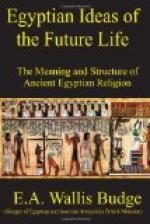20. “Praise be unto thee, O R[=a], thou exalted Power, who dost dwell in and illumine the celestial deep, behold [thy] body is Nu.” [Footnote: For the text see Annales du Musee Guimet: Le Tombeau de Seti 1. (ed. Lefebure), Paris, 1886, pl. v.]
In the paragraphs which follow R[=a] is identified with a large number of gods and divine personages whose names are not of such common occurrence in the texts as those given above, and in one way or another the attributes of all the gods are ascribed to him. At the time when the hymn was written it is clear that polytheism, not pantheism as some would have it, was in the ascendant, and notwithstanding the fact that the Theban god Amen was gradually being forced to the headship of the companies of the gods of Egypt, we find everywhere the attempt being made to emphasize the view that every god, whether foreign or native, was an aspect or form of R[=a].
The god Amen just referred to was originally a local god of Thebes, whose shrine was either founded or rebuilt as far back as the XIIth dynasty, about B.C. 2500. This “hidden” god, for such is the meaning of the name Amen, was essentially a god of the south of Egypt, but when the Theban kings vanquished their foes in the north, and so became masters of the whole country, Amen became a god of the first importance, and the kings of the XVIIIth, XIXth, and XXth dynasties endowed his temples on a lavish scale. The priests of the god called Amen “the king of the gods,” and they endeavoured to make all Egypt accept him as such, but in spite of their power they saw that they could not bring this result about unless they identified him with the oldest gods of the land. They declared that he represented the hidden and mysterious power which created and sustains the universe, and that the sun was the symbol of this power; they therefore added his name to that of R[=a], and in this form he gradually usurped the attributes and powers of Nu, Khnemu, Ptah, H[=a]pi, and other great gods. A revolt headed by Amen-hetep, or Amenophis IV. (about B.C. 1500), took place against the supremacy of Amen in the middle of the XVIIIth dynasty, but it was unsuccessful. This king hated the god and his name so strongly that he changed his own name into that of “Khu-en-Aten,” i.e., “the glory of the solar Disk,” and ordered the name of Amen to be obliterated, wherever possible, on temples and other great monuments; and this was actually done in many places. It is impossible to say exactly what the religious views of the king were, but it is certain that he wished to substitute the cult of Aten, a form of the Sun-god worshipped at Annu (i.e., On or Heliopolis) in very ancient times, for that of Amen. “Aten” means literally the “Disk of the Sun,” and though it is difficult to understand at this distance of time in what the difference between the worship of R[=a] and the worship of “R[=a] in his Disk” consisted, we may be certain that there must have




